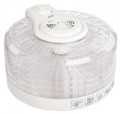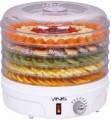Tray size
Horizontal dimensions of one dryer tray.
For round models, this paragraph usually indicates the diameter (for example, “Ø250”), for other cases — the length and width. Anyway, the information about the size allows you to estimate the total area and, accordingly, the capacity of the device. At the same time, note that a larger size affects the dimensions and weight of the structure, and also requires more heating power (ceteris paribus).
Power consumption
Rated power consumed by the dryer during operation.
This parameter is usually selected by manufacturers depending on the volume of the dryer: the larger the device, the more power is needed to effectively heat the working chamber. At the same time, models with the same volume may differ in power consumption. In such cases, it is worth considering that a higher power reduces the heating time, but affects the price of the device.
Thermostat
The presence of a
thermostat in the dryer — a regulator that allows you to set the temperature in the working chamber. Thus, the temperature regime can be chosen at your discretion — depending on the type of processed products and on the desired degree of drying.
Note that the specific format of this function may be different. The simplest option is a sensor that monitors the temperature in the working chamber and periodically turns on the heating when the air inside begins to cool. Such devices are quite simple and inexpensive. In more advanced dryers, there is another mode: the heater constantly supplies air of a certain temperature to the trays (this temperature is controlled based on data from the temperature sensor). This format is more expensive, but it allows you to provide the most uniform heating and has a positive effect on lifetime of the device.
In turn, the absence of a thermostat means that the dryer has only one operating temperature option. This limits the possibilities accordingly. However, this option also has advantages — simple design, reliability and low cost.
Temperature range
The temperature range that the dryer can provide in the working chamber.
The simplest models provide only one operating temperature option, usually from 50 °C to 60 °C. More advanced devices equipped with thermostats (see above) and can have a wide range of adjustment — this is very useful, because different temperature regimes are recommended for different products. To assess the general capabilities of a particular dryer, you can use the following table of temperatures recommended for drying:
— 35...40 °C — plant stems, greens;
— 40...45 °C — bread;
— 38...42 °C (in some cases up to 45 °C) — yoghurt;
— 50...55 °C — vegetables;
— 55...60 °C — fruits;
— 65...75 °C — meat, fish.
We emphasize that these are the most general, conditional data. The specific temperature may differ from the recommended one — depending on the thickness of the slices, the specific type of food, the desired result, etc. Detailed recommendations on this matter can be found in special sources.
Location of the fan (heater)
The location of the heating element (fan with heater) installed in the food dehydrator. This element can be installed at the
bottom,
top or
behind, here are the features of each of the options:
— Bottom. The classic and most common arrangement for heaters in food dehydrators is located at the bottom. This design choice offers two main advantages. Firstly, warm air is evenly distributed throughout the dryer's volume as it rises from the bottom. Secondly, these devices have compact dimensions in terms of width and depth, which are mainly determined by the size of the trays. This allows for more flexibility in terms of placement options. However, a potential drawback of the lower heater placement is the possibility of contamination, which can result in unpleasant odors. In such cases, disassembling and thoroughly cleaning the dryer may be required. Nonetheless, most manufacturers take steps to address this issue, making it less of a critical concern.
— Top. The safest location for the heater in a food dehydrator is considered to be at the top, as it minimizes the risk of moisture from the dried products coming into contact with the heater. Similar to the previously mentioned design, the width and depth of the food dehydrator do not exceed the size of the trays. However, dehydrators with a top-mounted heater may not provide uniform heating. Warm air tends t
...o accumulate in the upper part of the device, resulting in the upper trays being heated more than the lower ones. In theory, this can be advantageous for drying products that require different temperature conditions, as higher-temperature items can be placed higher in the dehydrator. However, in practice, it is challenging to account for the actual temperature difference accurately. This aspect becomes a clear disadvantage when drying uniform ingredients, as it requires periodic rearrangement of the trays to achieve even processing. As a result, there are fewer models with a top-mounted heater available nowadays.
— Behind. Food dehydrators in this category have a layout that differs from the previously described options. They resemble ovens with baking sheets, where a common working chamber is used instead of separate trays stacked on top of each other. Inside the chamber, lattice shelves are fixed with special slots or protrusions on the walls. The heater is located at the back of the "oven". This design is considered highly advanced, as it allows for easy removal and placement of individual trays without disturbing the others. It also provides very uniform heating and minimizes the mixing of odors between different levels. Moreover, the lattice shelves can be rearranged to increase the height of specific "trays". However, the drawbacks of models with a rear heater include their bulkiness and higher cost. As a result, this layout option is primarily used in semi-professional and higher-level food dehydrators.Overheat protection
Security system that turns off the power to the dryer when
the critical temperature in the working chambers is reached. This does not only save food from overdrying, but also prevents more serious consequences in the first place, such as a breakdown or even an ignition in the dryer, which is fraught with fire.

